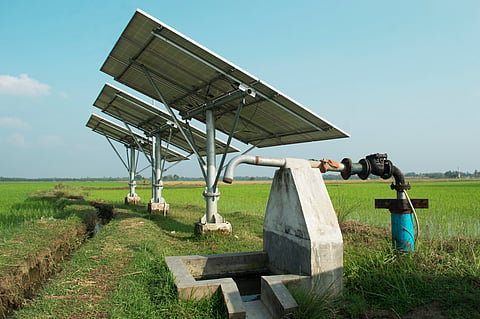A solar-led push through power feeder level modernisation is required to decarbonise agriculture
The agricultural sector is the third-largest direct consumer of electricity in India, accounting for 18 per cent of total consumption as of 2021. This demand is primarily driven by irrigation pumps, which currently rely on electricity generated from coal-based thermal power. The continued use of coal, combined with rising irrigation needs due to newer crop varieties, multiple crop cycles, and higher per-crop water consumption, presents a significant environmental and economic challenge.
Electricity for agricultural users is heavily subsidised — and in some states, even provided free of cost on unmetered connections. Distribution companies (DISCOMs) face financial strain, with the average cost of supply (ACoS) ranging from Rs 5–6 per kWh, while the revenue they recover is less than Rs 2 per kWh. This results in recurring losses for DISCOMs, making the case for a transition to clean, cost-competitive energy solutions all the more urgent.
There is a substantial opportunity to decarbonise the agricultural sector by shifting to solar energy, especially under existing government schemes.
One such initiative is the PM-KUSUM scheme, launched to reduce diesel usage in agriculture, provide water and energy security to farmers, and curb environmental pollution. Component C of the scheme aims to solarise 3.5 million grid-connected agriculture pumps through both individual systems and feeder-level solarisation (FLS). FLS allows all grid-connected pumps on a particular feeder to be powered by a single, larger solar power plant installed near the local substation.
This centralised solar plant supplies electricity directly to agricultural pumps via the feeder. To support implementation, Central Financial Assistance (CFA) of Rs 1.05 crore per MW is provided, with flexibility for projects to be executed under either the CAPEX or OPEX/RESCO models. Eligible bidders include individual farmers, groups of farmers, water-use associations, agricultural cooperatives, and traditional solar project developers.
Madhya Pradesh leads the way
In a recent development, Madhya Pradesh Urja Vikas Nigam Limited (MPUVNL) has invited proposals to set up grid-connected solar PV plants under Component C (FLS) of PM-KUSUM, targeting a total bid capacity of 1,200 MW. This is likely the largest single tender under the scheme so far.
The tender, launched under the Surya Mitra Krishi Feeder Scheme, is notable for including detailed data on over 1,900 substations — such as latitude-longitude coordinates, project capacity (in MW), point of delivery (11 kV), and bay availability (circuit connection points within substations).
This level of site-specific detail represents a proactive facilitation approach by MPUVNL. Typically, state nodal agencies release tenders with limited site information. MPUVNL has enhanced this process by offering various support mechanisms:
Interest subvention through the Agricultural Investment Fund (AIF) of up to three per cent for seven years
Reactive power compensation mechanisms via grid-tied inverters to support grid stability (via grid tied inverters and other electronics)
Assistance in securing credit from selected banks with standardised interest rates for solar projects under PM KUSUM C for specific to MP's landscape.
Comprehensive operational guidelines for various aspects of energy generation and plant management
Tariffs for PM-KUSUM Component C projects usually range between Rs 2.40 to Rs 3.10 per kWh, with a pre-fixed levelised tariff ceiling of Rs 3.22 per kWh. Recent tenders in states like Gujarat and Rajasthan have seen discovered tariffs below Rs 2.80 per kWh. It is expected that this tender will lead to even lower tariffs, benefitting Madhya Pradesh DISCOMs and improving the financial viability of the state's power distribution system. The applicable tariff will be valid for 25 years under a standard Power Purchase Agreement (PPA).
Impetus to local entrepreneurship
According to Manu Srivastava, Additional Chief Secretary, Department of Energy, Madhya Pradesh, the initiative will also support local entrepreneurship and generate employment opportunities. To ensure effective implementation, provisions have been made for capacity-building training and technical studies.
The bidding process will follow a single-stage, two-envelope format, where eligible project developers must first meet technical requirements outlined in the tender. Among the technically qualified bidders, the one offering the lowest tariff will be selected. Developers are responsible for securing land near the designated substations, either through ownership or a lease of 25 years.
This land can also be used to establish agri-photovoltaic (Agri-PV) systems, which integrate solar panels with crop cultivation. Madhya Pradesh already has two Agri-PV installations in the Sagar district. This initiative is expected to further advance the Agri-PV programme in the state, supporting integrated farm development while decarbonising agricultural power use through clean electricity.


